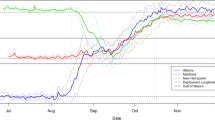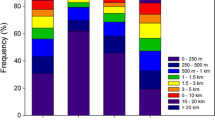Abstract
Common Crossbill (Loxia curvirostra) populations are dependent on specific key conifer species for their primary food supply, but many of these conifers standardly show irregular cone crop production. Consequently, the species has evolved a nomadic behavior, breeding in areas with a high crop production in given years. Northern European crossbills mostly forage on Norway Spruce (Picea abies) and migrate along a northeast–southwest gradient across Europe. In contrast, crossbills from Spain were considered to be resident until recent studies on crossbill populations in the Pyrenees showed that a fraction of the population may also migrate. The type of movements of these Spanish birds, however, remains virtually unknown. The aim of our study was to resolve the question of whether these birds displace on a small local scale or whether they actually move to a distinct non-breeding area for part of the annual cycle. We tracked 14 male Common Crossbills from the Pyrenees with light-level geolocators for an entire year. Our results suggest that these birds were resident; only one bird may have shown a west–east movement of up to 200 km along the Pyrenean axis. We conclude that movement of the Common Crossbill from the Pyrenees may predominantly consist of relocation to nearby mountain ranges in Iberia or vertically in altitude. We expect that such small-scale movements have implications for population dynamics, and we recommend further research with telemetry to resolve the details of this small-scale movement.
Zusammenfassung
Geolokatoren bestätigen den Standvogelstatus der Fichtenkreuzschnäbel in Südeuropa
Fichtenkreuzschnäbel (Loxia curvirostra) sind spezialisiert auf Nahrung von Nadelgehölz und sind deshalb von den unregelmäßig auftretenden Mastjahren ihrer Futterpflanzen abhängig. Eine evolutive Anpassung daran ist das nomadische Umherziehen zwischen Brutgebieten mit hohem Nahrungsangebot. Besonders nordeuropäische Populationen sind auf Fichtenbestände (Picea abies) angewiesen und ziehen innerhalb Europas entlang einer nordöstlich-südwestlichen Achse, während man von spanischen Fichtenkreuzschnäbeln bisher annahm, dass es sich um Standvögel handelte. Dieses Wissen wurde jedoch kürzlich von einer Studie in Frage gestellt, die zeigte, dass in einer gewissen Population in den Pyrenäen ein Teil der Vögel vielleicht auch umherziehen. In dieser Studie wollten wir wissen, ob diese Vögel nur lokal wandern, oder ob es tatsächlich eine saisonale Zugbewegung in ein vom Brutgebiet unterschiedliches Gebiet ist. Hierfür beloggerten wir 14 männliche Fichtenkreuzschnäbel während eines Jahres mit Geolokatoren. Es zeigte sich, dass mit einer Ausnahme alle Vögel ortstreu blieben und dass der eine Vogel wahrscheinlich 200 km in Ost-West Richtung entlang der Pyrenäen zog. Daraus schließen wir, dass Wanderungen von Fichtenkreuzschnäbeln in Spanien vor allem zwischen benachbarten Gebirgszügen und innerhalb von Gebirgen in vertikaler Richtung vorkommen. Wir erwarten, dass der lokale Austausch eine wichtige Komponente in der Dynamik lokaler Populationen spielt und wir empfehlen eine Telemetriestudie, um mehr über diese lokalen Bewegungen von Fichtenkreuzschnäbeln zu erfahren.



Similar content being viewed by others
References
Alerstam T (1993) Bird migration. Cambridge University Press, Cambridge
Alonso D, Arizaga J (2004) El verderón serrano (Serinus citrinella) en Navara: parámetros fenológicos y movimientos migratorios. Munibe 55:95–112
Alonso D, Arizaga J (2005) Efecto de la edad, el sexo y el tiempo en la biometría del piquituerto común (Loxia curvirostra curvirostra) en Navarra. Munibe 56:133–144
Alonso D, Arizaga J (2011) Seasonal patterns of breeding, moulting, and body mass variation in Pyrenean Common Crossbills Loxia curvirostra curvirostra. Ringing Migr 26:64–70
Alonso D, Arizaga J (2013) The impact of vagrants on apparent survival estimation in a population of Common Crossbills (Loxia curvirostra). J Ornithol 154:209–217
Andueza M, Barba E, Arroyo JL, Feliu J, Greño JL, Jubete F, Lozano L, Monrós JS, Moreno-Opo R, Neto JM, Onrubia A, Tenreiro P, Valkenburg T, Zumalacárregui C, González C, Herrero A, Arizaga J (2013) Connectivity in Reed Warblers Acrocephalus scirpaceus between breeding grounds in Europe and autumn stopover sites in Iberia. Ardea 101:133–140
Arizaga J, Alonso D, Hobson K (2014) Disentangling the origin of crossbills using morphology and isotopic (δ2H) characters. Are southern European crossbills restricted to population-specific key resources? J Ornithol 155:1027–1035
Bächler E, Hahn S, Schaub M, Arlettaz R, Jenni L, Fox JW, Afanasyev V, Liechti F (2010) Year-round tracking of small trans-Saharan migrants using light-level geolocators. PLoS One 5:e9566
Badosa E, Bonada Á, López A, Potrony D, Saló R (2007) First long-distance movement of a Tengmalm’s Owl Aegolius funereus recorded in the Pyrenees, Spain. Revista Catalana d’Ornitología 23:44–47
Benkman CW (1993) Adaptation to single resources and the evolution of crossbill (Loxia) diversity. Ecol Monogr 63:305–325
Berthold P (1996) Control of bird migration. Academic Press, London
Björklund M, Alonso D, Edelaar P (2013) The genetic structure of crossbills suggests rapid diversification with little niche conservatism. Biol J Linn Soc 109:908–922
Borrás A, Senar JC (2003) Piquituerto común, Loxia curvirostra. In: Martí R, Del Moral JC (eds) Atlas de las aves reproductoras de España. DGCN-SEO/BirdLife, Madrid, pp 588–589
Borrás A, Cabrera T, Cabrera J, Senar JC (2003) The diet of the Citril Finch (Serinus citrinella) in the Pyrenees and the role of Pinus seeds as a key resource. J Ornithol 144:345–353
Borrás A, Cabrera J, Colome X, Cabrera T, Senar JC (2011) Patterns of connectivity in Citril Finches Serinus citrinella: sympatric wintering of allopatric breeding birds? Bird Study 58:257–263
Cramp S, Perrins CM (1994) Handbook of the birds of Europe, the Middle East and North Africa, vol 8. Oxford University Press, Oxford
Edelaar P, Alonso D, Lagerveld S, Senar JC, Björklund M (2012) Population differentiation and restricted gene flow in Spanish crossbills: not isolation-by-distance but isolation-by-ecology. J Evol Biol 25:417–430
Ekström PA (2002) Blue twilight in a simple atmosphere. Proc SPIE 4815:73–81
Finch T, Saunders P, Avilés JM, Bermejo A, Catry I, de la Puente J, Emmenegger T, Mardega I, Mayet P, Parejo D, Račinskis E, Rodríguez-Ruiz J, Sackl P, Schwartz T, Tiefenbach M, Valera F, Hewson C, Franco A, Butler SJ (2015) A pan-European, multipopulation assessment of migratory connectivity in a near-threatened migrant bird. Divers Distrib 21:1051–1062
Fraser KC, Stutchbury BJM, Silverio C, Kramer PM, Barrow J, Newstead D, Mickle N, Cousens BF, Lee JC, Morrison DM, Shaheen T, Mammenga P, Applegate K, Tautin J (2012) Continent-wide tracking to determine migratory connectivity and tropical habitat associations of a declining aerial insectivore. Proc R Soc Lond B Biol Sci 279:4901–4906
Fudickar AM, Wikelski M, Partecke J (2012) Tracking migratory songbirds: accuracy of light-level loggers (geolocators) in forest habitats. Methods Ecol Evol 3:47–52
Lisovski S, Hahn S (2012) GeoLight–processing and analysing light-based geolocator data in R. Methods Ecol Evol 3:1055–1059
Lisovski S, Hewson CM, Klaassen RHG, Korner-Nievergelt F, Kristensen MW, Hahn S (2012) Geolocation by light: accuracy and precision affected by environmental factors. Methods Ecol Evol 3:603–612
Marquiss M, Newton IAN, Hobson KA, Kolbeinsson Y (2012) Origins of irruptive migrations by Common Crossbills Loxia curvirostra into northwestern Europe revealed by stable isotope analysis. Ibis 154:400–409
Naef-Daenzer B (2007) An allometric function to fit leg-loop harnesses to terrestrial birds. J Avian Biol 38:404–407
Newton I (1972) Finches. Collins, London
Newton I (2006) Movement patterns of common crossbills Loxia curvirostra in Europe. Ibis 148:782–788
Newton I (2008) The migration ecology of birds. Academic Press, London
Schmaljohann H, Buchmann M, Fox J, Bairlein F (2012) Tracking migration routes and the annual cycle of a trans-Sahara songbird migrant. Behav Ecol Sociobiol 66:915–922
Senar JC, Borras A, Cabrera T, Cabrera J (1993) Testing for the relationship between coniferous crop stability and Common Crossbill residence. J Field Ornithol 64:464–469
Stutchbury BJM, Tarof SA, Done T, Gow E, Kramer PM, Tautin J, Fox JW, Afanasyev V (2009) Tracking long-distance songbird migration by using geolocators. Science 323:896
Tøttrup AP, Klaassen RHG, Strandberg R, Thorup K, Kristensen MW, Jargensen PS, Fox J, Afanasyev V, Rahbek C, Alerstam T (2012) The annual cycle of a trans-equatorial Eurasian–African passerine migrant: different spatio-temporal strategies for autumn and spring migration. Proc R Soc B Biol Sci 279:1008–1016
Tucker GM, Heath MF (2004) Birds in Europe: population estimates, trends and conservation status. BirdLife International, Cambridge
Acknowledgments
This research was funded by D. Alonso and the Swiss Ornithological Institute. Authorization to ring crossbills was obtained from the Government of Navarra. We thank J.M. Barbarín, A. Díaz, B. Fernández, and J. Torrea for their collaboration in the field work. The Swiss Federal Office for the Environment provided financial support for the development of the data loggers (UTF-Nr. 254, 332, 363, 400). We thank two anonymous referees who provided valuable comments which helped us improve an earlier version of this work.
Author information
Authors and Affiliations
Corresponding author
Additional information
Communicated by F. Bairlein.
Electronic supplementary material
Below is the link to the electronic supplementary material.
Appendix
Appendix
See Table 1.
Rights and permissions
About this article
Cite this article
Alonso, D., Arizaga, J., Meier, C.M. et al. Light-level geolocators confirm resident status of a Southern European Common Crossbill population. J Ornithol 158, 75–81 (2017). https://doi.org/10.1007/s10336-016-1388-5
Received:
Revised:
Accepted:
Published:
Issue Date:
DOI: https://doi.org/10.1007/s10336-016-1388-5




